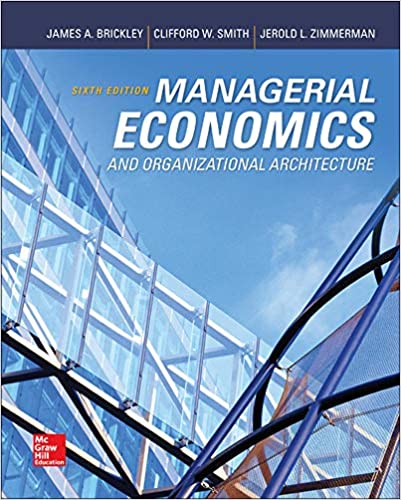
Managerial Economics & Organizational Architecture 6th Edition by James Brickley , Clifford Smith ,Jerold Zimmerman
Edition 6ISBN: 978-0073523149
Managerial Economics & Organizational Architecture 6th Edition by James Brickley , Clifford Smith ,Jerold Zimmerman
Edition 6ISBN: 978-0073523149 Exercise 15
ANALYZING MANAGERIAL DECISIONS: The Copper Box Company
You have been hired as a consultant to the CEO of the Copper Box Company. This company holds two patents, one for the technology for making the copper boxes and the other for a copper box design. The patent production technology belongs to the manufacturing division and the unique patented copper box design is sold by the distribution division. Distribution buys the boxes from manufacturing, and both divisions are run as profit centers. Manufacturing sells some of the copper boxes to outside firms, but outsiders cannot buy the patented copper boxes from manufacturing directly. These boxes are only available through the distribution division. Further assume that manufacturing has enough capacity to sell both internally and externally. Thus, the opportunity cost of manufacturing's transfer is its marginal production cost.
The CEO of the Copper Box Company believes strongly in decentralization and the principle that the two division managers should be free to set the prices of their own products, including the right of manufacturing to set the price that distribution pays for the boxes produced by manufacturing. Write a memo to the CEO explaining why such a policy fails to maximize the value of the Copper Box Company.
You have been hired as a consultant to the CEO of the Copper Box Company. This company holds two patents, one for the technology for making the copper boxes and the other for a copper box design. The patent production technology belongs to the manufacturing division and the unique patented copper box design is sold by the distribution division. Distribution buys the boxes from manufacturing, and both divisions are run as profit centers. Manufacturing sells some of the copper boxes to outside firms, but outsiders cannot buy the patented copper boxes from manufacturing directly. These boxes are only available through the distribution division. Further assume that manufacturing has enough capacity to sell both internally and externally. Thus, the opportunity cost of manufacturing's transfer is its marginal production cost.
The CEO of the Copper Box Company believes strongly in decentralization and the principle that the two division managers should be free to set the prices of their own products, including the right of manufacturing to set the price that distribution pays for the boxes produced by manufacturing. Write a memo to the CEO explaining why such a policy fails to maximize the value of the Copper Box Company.
Explanation
Decentralization is an organizational st...
Managerial Economics & Organizational Architecture 6th Edition by James Brickley , Clifford Smith ,Jerold Zimmerman
Why don’t you like this exercise?
Other Minimum 8 character and maximum 255 character
Character 255


